Things to do in Kakadu National Park
There’s a time for everything in Australia’s largest national park, where new accommodation and native ingredients are taking centre stage.
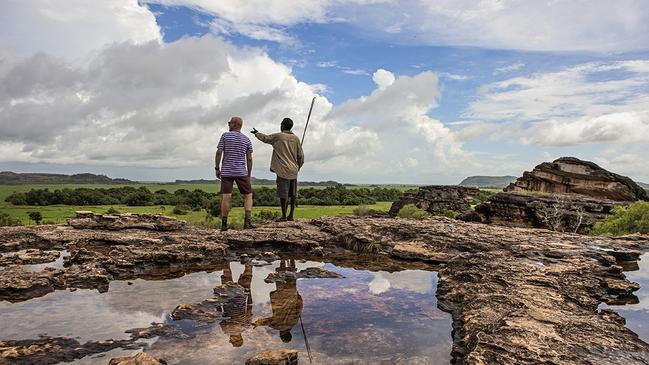
Ben Tyler has a warm demeanour and winning smile, but his eyes are sharply observant. He is a Bininj man with a mission for his home of Kakadu. Early morning, Ben is leading a small group along the banks of Lake Jabiru in the national park. And while Kakadu is memorable for grand vistas – its escarpment, gorges, monsoon forests and wetlands – today we are going small in search of the less visible. It’s bush tucker we’re scouring for, not least Kakadu plum, and birds and insects that are harbingers of a new season. Ben is showing us his country and we are learning to look at it through his eyes. It is knowledge that has been handed down to the foodie and entrepreneur by his family, particularly his mum, Jessie.
Accompanying us is educator Diane Lucas, who has co-authored with Ben a children’s book, Walking in Gagudju Country: Exploring the Monsoon Forest, and their illustrator Emma Long and her family. Diane came to Kakadu from Sydney in 1983 and when asked by her friends when she’d be “returning to civilisation”, told them, “I’ve found civilisation.” All 65,000 years of it.
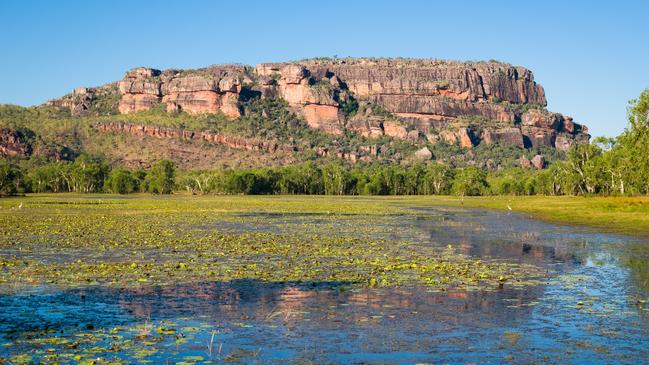
Our walk is part of the nine-day Taste of Kakadu Festival, held in May, but many of the cultural and cuisine experiences are available for visitors throughout the year. Think: ground oven feasts, Indigenous ranger-led rock art tours and walks on country, and croc cruises (with canapes). For the extent of this national park’s marvels, take a Kakadu Air scenic flight, which also passes over the now-closed Ranger uranium mine.
READ MORE: The perfect perch for bird week | Australia’s best waterborne adventures | Top end safari with a watery twist | Where to have a safari-style stay | Crocs, cattle and canapes in the Top End
Ben, who spent part of his childhood at Patonga Homestead beside Jim Jim Creek when it was a hunting camp before the area was declared a national park, founded Kakadu Kitchen to retail Indigenous-branded bush tucker, and has recently partnered with Tim Triggs, of Sydney-based ALTD Spirits, to distil non-alcoholic, ready-to-drink cocktails. Their first, An-marabula (Native Peach) Bellini, is a sensation and has been a big seller, and they are experimenting with other foraged ingredients.
For Ben and Tim, the non-alcoholic product is a passion. Grog has taken a huge toll in his community, Ben says. “Not only my community, all communities.” His mission is to strengthen his people and help Kakadu prosper. He also teams with chef Phil Foote of Mimi’s Restaurant at Cooinda Lodge, in the park’s heart, to offer a regular Full Moon Feast to reflect the six Kakadu seasons (see More to the Story). I sample the Yekke season feast, which features smoked buffalo, wild-caught barramundi ceviche and smoked duck. Add the flavours of wild currants, water lily stem, bush yam and, in a marinated strawberry and Kakadu plum dessert, green ants. Bush tomato damper with salt bush tops off a meal to remember under the stars.
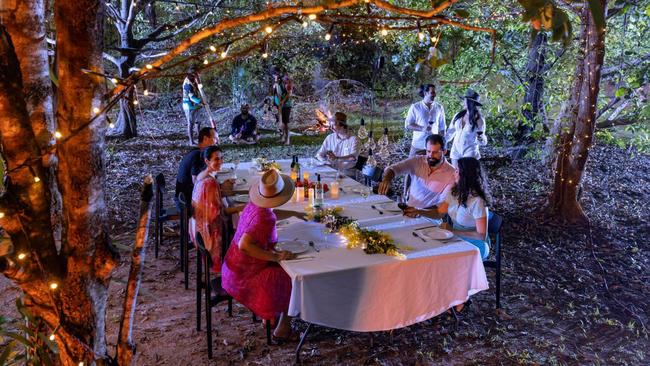
For my visit I have stayed at two properties – Mercure Kakadu Crocodile Hotel in Jabiru and the brand-new Yellow Water Villas at Cooinda Lodge. The Croc, in the shape of the reptile (the pool is in its stomach), has won global recognition for weirdness since it opened in 1988 and, in truth, was a little less snappy on a previous visit. I find it appealing and comfortable this time around, with an admirable art gallery off reception that helps balance crocodile kitsch. The Croc is close to festival HQ, Bowali Visitor Centre, which presents an informative history of Kakadu, and Marrawuddi Arts & Culture, a showcase for work by local artists.
On display in its gallery are edge-ground stone axes and grinding stones from Madjedbebe that were found at the 65,000-year level of the archaeological site.
Yellow Water Villas take Cooinda’s accommodation offerings up a notch to include five luxury eco-retreats alongside lodge guestrooms and a camping ground. Built on stilts to minimise environmental impact, the villas alongside Yellow Water Billabong have a safari glamping feel, with glass doors opening to a wide veranda and two canvas side walls with screened “windows” waiting to be unzipped.
The king-size bed is ultra-comfy and the air-conditioned villa has two daybeds, table for two and fully equipped kitchen. Cooking is on a barbecue on the deck, where there is dining furniture and a tub. At the time of my visit, this bathing option was awaiting a privacy screen, but the ensuite bathroom, grey-slate tiled and deliciously cool after a dusty day out, has a spacious shower recess and is stocked with Kakadu Organics products.
The villas offer a fine collection of books and are decorated with arts and crafts by Cooinda artists and from Marrawuddi Gallery. Each unit is named after an Indigenous animal – mine is Gabor, or green ant, a depiction of which is etched in the front door mat. This far and no further, thanks guys.
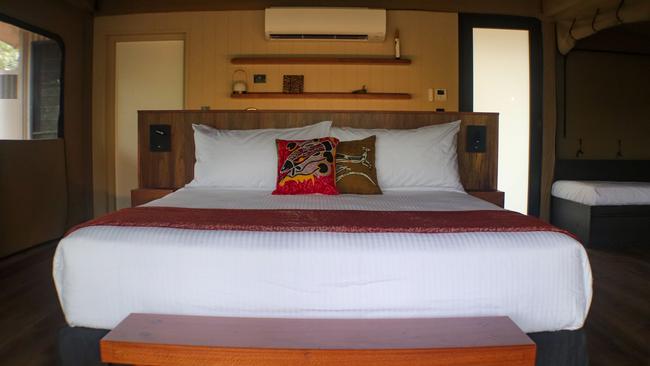
Cooinda is within easy driving distance of the spectacular rock outcrop Nourlangie (although a sign urges visitors to use the right names, Burrunggui for the upper area and Anbangbang for the lower). We have seen the orange-red beauty at sunset of these cliffs from the adjacent Nawurlandja lookout, but next morning we are in the hands of bush-smart Indigenous guide Johnnie and young sidekick Oscar, whose flashes of wit make for an entertaining, if irreverent, duo. We are here to learn about plants, wildlife (a kingfisher here, a drongo there and, yes, a snake and spider or two), but also about the Dreamtime, or Creation time as Johnnie prefers to call it. The rock art and the stories behind it are a wonder and we can only try to grasp their cultural significance in a short time. This is the home of Namarrkon, or Lightning Man, responsible for the spectacular electrical storms in the wet season. After the walk, we make our way to Anbangbang Billabong, on the banks of which the enterprising Hunter family have been preparing lunch in a traditional earth oven since before dawn. Now, as the oven’s bark layers (and foil) are peeled back, the big reveal – succulent beef, sweet potato and pumpkin and, cooked separately over hot coals, four freshly caught barramundi. This is food-lovers’ heaven.
If my short break began with an appreciation of the small, intense world of foraging, it is about to end big. Try large crocodiles in the wild just a body-length away. But the Yellow Water sunset cruise is about more than viewing these prehistoric reptiles. It is about a glorious going down of the sun, its ochre colour intensified by the smoke of the first controlled burnings of the season and offset by silvery clouds. Flocks of waterbirds are on the wing, and the lilies are lovely. But don’t take your eyes off that croc for a second.
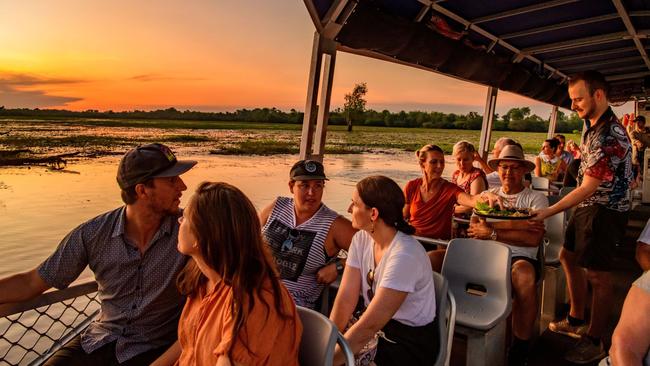
MORE TO THE STORY
Take your pick of the six seasons at Kakadu, determined by the weather and observations of plants and wildlife, but note some Kakadu attractions, such as Jim Jim Falls, have dry season access only.
Yekke (May-June): The rains have finished and it’s cooler. Dragonflies are in the air and kapok trees flowering. Water lilies abound.
Wurrgeng (June-August): Cooler, dry. Creeks stop flowing, magpie geese crowd the billabongs. Patch burning.
Kurrung (August-October): Hot, dry. Flowering plants such as white and red apple are fragrant. White-breasted wood swallows arrive as thunderclouds build.
Kunumeleng (October-December): Pre-monsoon. Lightning flashes, streams flow again. Waterbirds spread out and barramundi move from waterholes to the estuaries to breed.
Kudjewk (December-March): Monsoon, hot and humid. An explosion of plant and animal life, with abundant fruits. Spear-grass towers.
Bankerreng (April): Harvest time but beware storms from the east. Flood waters recede. Time to collect magpie goose eggs and go fishing.
Source: This Is Stone Country
IN THE KNOW
The annual Taste of Kakadu is held in May, organised by Parks Australia.
Rooms at Mercure Kakadu Crocodile Hotel from about $430 a night. Yellow Water Villas, about $950 a night, including breakfast.
Graham Erbacher was a guest of Kakadu Tourism.

To join the conversation, please log in. Don't have an account? Register
Join the conversation, you are commenting as Logout